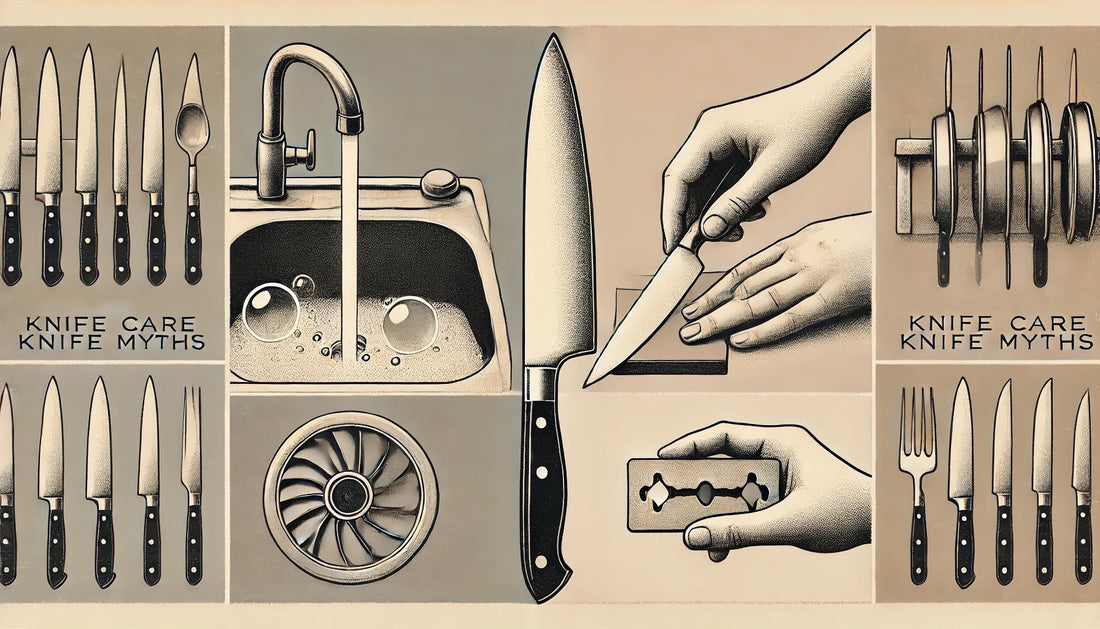
Knife Care Myths: Debunking Common Misconceptions About Knife Maintenance
Share
When it comes to maintaining your kitchen knives, there’s a lot of conflicting advice out there. Some of this advice can do more harm than good, leading to dull blades, damaged edges, and even unsafe cooking conditions. At SEKKIN, we believe that every home chef deserves to get the most out of their knives. That’s why we’re here to set the record straight by debunking some of the most common knife care myths.
Myth 1: Dishwashers Are Safe for All Knives
One of the most pervasive myths is that it’s okay to toss your knives into the dishwasher. While it might seem like a convenient option, the reality is that dishwashers are a knife’s worst enemy. The intense heat, harsh detergents, and jostling inside the machine can damage the blade, dull the edge, and even lead to rust spots.
The truth: Always hand wash your knives with warm, soapy water and dry them immediately. This simple step can significantly extend the life of your knives.
Myth 2: Honing and Sharpening Are the Same Thing
Many people confuse honing with sharpening, thinking they’re doing the same thing when, in fact, they serve different purposes. Honing is the process of realigning the edge of the blade, which gets slightly bent with regular use. Sharpening, on the other hand, involves removing metal from the blade to create a new, sharp edge.
The truth: Regular honing keeps your knife performing well between sharpenings, but it’s important to sharpen your knife periodically to maintain its cutting efficiency. A good rule of thumb is to hone your knife after every few uses and sharpen it every few months, depending on how often you cook.
Myth 3: All Sharpening Tools Are Created Equal
There’s a belief that any sharpening tool will do the job just fine. However, not all sharpening tools are suitable for every knife. Electric sharpeners, for example, can be too aggressive for delicate Japanese-style knives, potentially damaging their fine edges.
The truth: Choose a sharpening tool that’s appropriate for your knife. For SEKKIN knives, we recommend using a whetstone or a manual sharpener designed specifically for fine edges. This ensures that your knives are sharpened evenly and safely.
Myth 4: It’s Impossible to Over-Sharpen a Knife
Some people think that the sharper the knife, the better, and that sharpening frequently will only improve the knife’s performance. However, over-sharpening can wear down the blade, shortening the knife’s lifespan and making it prone to chipping.
The truth: While keeping your knife sharp is crucial, moderation is key. Sharpen your knife only when necessary to maintain the balance between sharpness and longevity.
Myth 5: Storing Knives in a Drawer Is Fine
Storing knives loosely in a drawer is a common practice, but it’s one of the worst things you can do to your blades. When knives knock against each other, it can lead to chipped edges and dullness. Plus, it’s a safety hazard.
The truth: Always store your knives in a knife block, on a magnetic strip, or in a protective sheath. These options keep your knives safe, sharp, and ready for use.
Myth 6: Rusted Knives Are Beyond Repair
Finding rust spots on your beloved knife can be disheartening, leading many to believe that the knife is ruined. However, light rust can often be removed with the right care.
The truth: To remove light rust, gently scrub the affected area with a mixture of baking soda and water or a rust eraser. Once the rust is gone, be sure to dry your knife thoroughly after each wash to prevent future rusting.
Conclusion: Taking Care of Your Knives the Right Way
Proper knife care doesn’t have to be complicated, but it does require knowing the facts. By debunking these common myths, we hope to help you keep your knives in top condition for years to come. Remember, a well-maintained knife not only performs better but also makes cooking safer and more enjoyable.
At SEKKIN, we’re committed to providing you with the highest quality knives and the knowledge to care for them properly. Stay sharp, and happy cooking!
